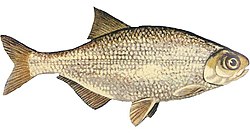| Mooneye | |
|---|---|
 | |
| Hiodon tergisus | |
| Scientific classification | |
| Kingdom: | Animalia |
| Phylum: | Chordata |
| Class: | Actinopterygii |
| Order: | Hiodontiformes |
| Family: | Hiodontidae Cuvier & Valenciennes, 1846 |
| Genus: | Hiodon Lesueur, 1818 |
| Species | |
 | |
| Synonyms | |
| |
Hiodontidae, commonly called mooneyes, is a family of ray-finned fish with a single included genus Hiodon. The genus comprise two extant species native to North America and three to five extinct [1] species recorded from Paleocene to Eocene age fossils. They are large-eyed, fork-tailed fish that superficially resemble shads. The vernacular name comes from the metallic shine of their eyes.
The higher classification of the mooneyes is not yet fully established. Some sources have place them in their own order, Hiodontiformes , while others retain them in the order Osteoglossiformes .


